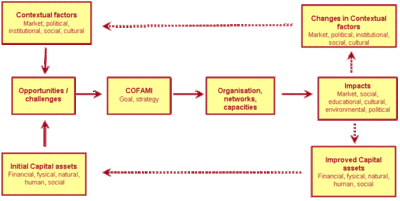Limiting and enabling factors
The contextual environment of natural conditions, markets, institutional and political framework etc. together with the available capital assets (financial, natural, physical, social, human and cultural capitals) constitute limiting and enabling factors for the development of COFAMIs; they and define the choice of strategies and the configuration of internal and external networks. During the process of development, configuration and reconfiguration in the different phases of the lifecycle of COFAMIs, the availability of the different forms of capital assets determine the ability to deal with changes, to react on trends and manage processes of adaptations to changing contextual conditions. Thus the overall hypothesis, to be verified or falsified in the case studies, is that: “The success of a COFAMI depends on the establishment and development of an effective organisation and the building of networks that enable it to overcome limiting factors in policy, market and territorial contexts and valorise enabling factors in these domains.”
The results of the case studies have demonstrated that there are no specific factors which act limiting or enabling on each and every COFAMI. It is the combination of different contextual factors with the available resource assets, resulting in specific strategies, organisational forms and networks which make a COFAMI successful or not.
For instance a place specific contextual factor like urban remoteness may foster territorial networks between rural / supply chain actors and serve as basis for quality differentiation. Proximity to urban centers on the other hand may encourage producer – consumer initiatives, the development of dedicated markets and / or supply of services. New technologies especially in the information and communication technology (internet) can eliminate some of the place dependent shortcomings and make ‘short chains at a distance’ possible.
Rural attractiveness can serve as a starting point for regional quality differentiation, marketing of public goods & services and region branding initiatives. The utilization of these potentials is to some extend depending on socio-cultural factors like the tradition of farmers´ cooperation, a common political or ideological motivation or a strong regional cultural identity. Globalization and ´price squeeze´ may cause agony or stimulate the search for added value and the establishment of new chain relations. New societal demands can result in a loss of self confidence or create new markets (e.g.: green care, agro-tourism etc.).
Basically we identified four strategies which are applied:
- Farmers initiated COFAMIs often work successful with quality differentiation in chain networks which focus on product quality (e.g. regional speciality, quality standards, labelling).
- Other successful initiatives use quality differentiation in territorial networks and/or dedicated markets. They build on process quality (e.g. organic, face-to-face).
- COFAMIS developing markets for new rural goods & services are often initiated by non-farmer partners and policy actors. Their networks often integrate a diversity of actors (e.g. region branding).
- Finally policy and institutional actors are often instrumental to develop markets for non-food / energy products. Sucessful initiatives build on preexisting networks but maintain the flexibility of an innovative approach.
Limiting and enabling factors depend on the life-cycle stage of the initiative: In the founding phase key initiators and their leadership play a crucial role. They have to manage different types of social capital (bonding, bridging and linking). Often the possibility of using initial financial support requires the formalisation of the organisation and this decides who is in and who is out. For the further development a coherent view on the COFAMI´s strategy is needed (like a common ideology to unify the diversity of actors). The role of pre-existing networks can be positive for resource mobilisation but may lead to a path dependency which can limit the openness to new approaches. For the later development the flexibility and capacity to adapt to changing contexts is crucial. This implies the reaction to changing trends (reactive and proactive), learning from shocks to build up resilience, creating a learning milieu (continuous professionalization) and the existence of an internal communication which balances participation and efficiency.
 This website was archived on February 10, 2016 and is no longer updated.
This website was archived on February 10, 2016 and is no longer updated.

